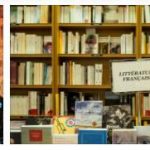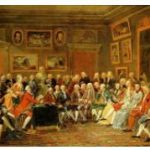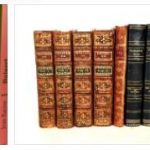Nouvelle critique
The literary criticism provided important impulses for contemporary French literature. Already in the literary-theoretical-essayistic works of G. Bataille, M. Blanchot and G. Bachelard, the literary aspect in the narrower sense was closely connected with the reflection on language; this has been particularly popular since the 1960s as part of the “Nouvelle critique” in the context of the magazines “Tel Quel” (around P. Sollers; founded in 1960, since 1983 “L’infini”) and “Change” (around J.-P. Faye; founded in 1968). Based on the structuralist method of various human sciences, e.g. B. linguistics (F. de Saussure), phenomenology (M. Merleau-Ponty), psychoanalysis (J. Lacan), ethnology and cultural anthropology (C. Lévi-Strauss, M. Foucault, M. Leiris) and Marxist social theory (L. Althusser), the literary work of art emerged from his historical and existential context resolved and the subject of literary analysis as an autonomous system of mutually referring signs. The representatives of the “Nouvelle Critique” included, among others. R. Barthes (“Le degré zéro de l’écriture”, 1953; German “At the zero point of literature”), T. Todorov, Gérard Genette, J. Starobinski, L. Goldmann, C. Ollier, D. Roche, Faye,Sollers, Hélène Cixous and Julia Kristeva. At the end of the 1960s, a post-structuralist phase of criticism set in (“nouvelle nouvelle critique”), which turned in particular to the linguistic process in its historicity and the role of the subject in the development of linguistic productivity.
End of the 20th and beginning of the 21st century
After the »terreur théorique«, French literature opened up in the 1970s and 80s. In contrast to the hermetic self-centeredness of the Nouveau Roman, stories were told again (Le Clézio, Sylvie Germain). Detective novels (Jean-Claude Izzo, * 1945, † 2000; Daniel Pennac, * 1944; Jean-Christophe Grangé, * 1961; Fred Vargas; Didier Daenickx, * 1949) established themselves from the close connection between literature and film that had existed since auteur cinema), Science fiction and comics as a broad counterculture. The mutual relationships between film and literature expressed themselves in an unconventional style and a shortened everyday language. Through filming of their novels, young authors such as P. Djian (“37.2 ° Le Matin”, 1985; German “Betty Blue. 37.2 ° am Morgen”) and P. Bruckner, “Bitter Moon”, German, based on the novel »Lunes de fell«, 1981) to international fame. The cult author Djian hit the nerve of the 1980s, who describes problems of everyday life and human relationships in his novels in a humorous style and taboo-free language. BRA. Lévy turned to the novel after dedicated essays on the criticism of French fascism (“Le diable en tête”, 1984; German “The devil in the head”). H. Guibert’s trilogy of novels about his creeping AIDS death attracted a lot of attention in the early 1990s.
The current literary landscape in France is diverse. Forms of perception and fields of experience differentiated themselves under the influence of the new media. Myths and belief in progress lost their pathos, the importance of privacy increased. The aesthetic stylistic devices today are as diverse as the topics and are casually combined. Both representatives of the Neo-Nouveau Roman and J.-P. Toussaint and F. Bon as well as authors as diverse as J. Échenoz, J. Rouaud, Leslie Kaplan (* 1943), Alexandre Jardin (* 1965), Marie Redonnet (* 1948), Y. Queffélec and E.-E. Schmitt (“Monsieur Ibrahim et les fleurs du Coran”, 2001; German “Monsieur Ibrahim and the flowers of the Koran”) critically deal with reality in a playful way, often focusing on the private sphere. Check zipcodesexplorer.com to see more about France and other countries in the world.
The play with reality and fiction, which is typical of literature at the turn of the 20th to the 21st century, often springs from a source of commercial interests, literary fashions and political events. What is striking is the unaffected, concise language with which western consumer society, sexuality and love are thematized in times of globalization. In “Windows on the world” (2003; German) F. Beigbeder deals with people’s helplessness in the face of terrorist threats.
France’s most controversial authors include M. Houellebecq, whose provocative and aggressive style sparked heated debates, Cathérine Breillat (* 1948), F. Beigbeder, Virginie Despentes (* 1969) and Catherine Millet (* 1948). Word creations like “Deprimism” or “Nouvelle Pornographie” try to describe this trend towards moral emptiness, cynicism and cultural pessimism. The absurd humor of Christian Oster (* 1949) shows a different way of dealing with human longings and weaknesses. Marie N ′ Diaye, Marie Darrieussecq (* 1969), Hélène Lenoir, Paule Constant and Emmanuèle Bernheim (* 1949) are representatives of a self-confident, feminist, imaginative, sometimes bizarre literature written by young authors such as Anna Gavalda (* 1970), Anne-Sophie Brasme (* 1984; »Respire«, 2001; German » See you sleep ”) and Flavia Bujor (* 1989;“ La prophétie des pierres ”, 2002; German“ The Oracle of Oonagh ”) is continued. The highest growth rates in the French book market are currently recorded by comics from a wide variety of literary directions. International bestsellers also include the novels by Marc Levy (* 1961), which deal with great human emotions .
Increasingly, immigrant authors are finding a publisher and their audience in France, such as A. Makine from Russia or M. Del Castillo from Spain. Eminent authors such as J. Semprùn and M. Kundera have been writing in French for a long time and are publishing in France. The new translation of the Bible by 20 prominent authors (including Frédéric Boyer, * 1961; Bon; Échenoz; Roubaud; N ′ Diaye; J.-L. Benoziglio; V. Novarina) attracted attention in autumn 2001). The Hebrew and Greek original text was translated into a modern, concise language in verse form and prose in a stylistically demanding manner.
In the French-language poetry of the 1990s, no outstanding trend can be isolated; existing tendencies are continued. Following the ideal of the simple style, P. Jaccottet and J. Réda deal with life and death and nature in their lyrical works. Outstanding authors whose work appeared in the previous decades have only recently reached a wider audience (E. Jabès; Eugène Guillevic, * 1907, † 1997). Inspired by the versatility of the French language, Novarina’s eloquent, intelligent and equally absurd poems unfoldoften their full effectiveness only on stage. With his experimental plays on word, space, time, body, music and dance, he breaks all conventional barriers.
In the field of drama, Yasmina Reza in particular achieved international recognition with her plays in the 1980s and 1990s. In keeping with the tradition of conversation theater, she achieves a great dramatic effect with little means (»Art«, 1994; German »Art«). In addition to E.-E. Schmitt (»Variations énigmatiques«, 1996; German »Enigma«) Coline Serreau (* 1947; »Trois hommes et un couffin«, 1986; German »Three men and a baby«; »Lapin, lapin«, 1998, German »Hase, Hase«), Romain Weingarten (* 1926, † 2006; »La mort d’August«, 1986), J.-C. Grumberg (“Zone libre”, 1990).
So far, these French-born writers have received the Nobel Prize for Literature: S. Prudhomme (1901), F. Mistral (1904), R. Rolland (1915), A. France (1921), H. Bergson (1927), R. Martin du Gard (1937), A. Gide (1947), F. Mauriac (1952), A. Camus(1957), Saint-John Perse (1960), J.-P. Sartre (1964; not accepted), C. Simon (1985), J.-M. G. Le Clézio (2008) and P. Modiano (2014).








